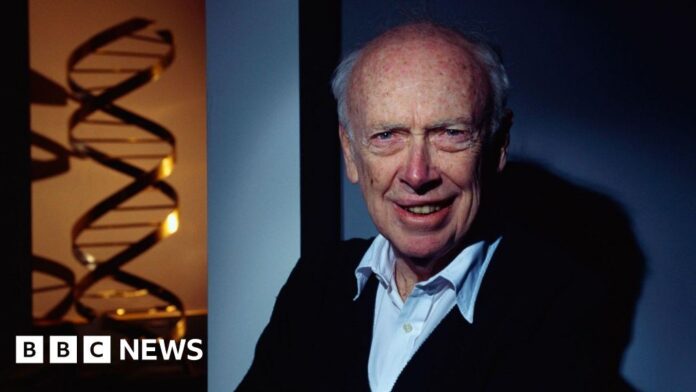James Watson, the brilliant but polarizing biologist who co-discovered the structure of DNA, revolutionized our understanding of life and sparked decades of ethical debate with his pronouncements on race, intelligence, and social policy. He died on August 12, 2023, at the age of 97.
In February 1953, Watson, then a young American researcher working at Cambridge University’s Cavendish Laboratory, and his British colleague Francis Crick stunned the scientific world with their announcement: they had deciphered the “secret of life.” Their discovery—the double-helix structure of deoxyribonucleic acid (DNA)—provided the missing piece in understanding how genetic information is stored and replicated. This breakthrough, alongside Mendel’s laws of heredity and Darwin’s theory of evolution, cemented its place as one of the most significant scientific achievements of all time.
The model Watson and Crick painstakingly constructed revealed that DNA wasn’t just a passive support structure for proteins but an elegant molecule shaped like a twisted ladder—a double helix. Each rung of this ladder consisted of pairs of chemical bases, forming a genetic code. The key insight was that each strand acted as a template for creating its complementary partner, effectively explaining how genetic information could be faithfully passed down through generations.
This discovery ushered in the era of molecular biology and opened Pandora’s Box of ethical questions surrounding gene manipulation, cloning, genetically modified organisms (GMOs), and more. The ability to read and write the language of life, as Watson and Crick had unlocked it, promised incredible advancements but also raised profound moral dilemmas.
The Nobel Prize in Physiology or Medicine came in 1962, shared by Watson, Crick, and Maurice Wilkins, a colleague at King’s College London who contributed X-ray diffraction data crucial to the discovery. However, the story of how the key data—particularly Rosalind Franklin’s groundbreaking X-ray photographs of DNA—were obtained remains fraught with controversy.
Franklin, a skilled chemist who pioneered the technique used in capturing these images, tragically died of cancer at age 37 before receiving proper recognition for her pivotal role. Many scientists believe she deserved to share the Nobel Prize and that Watson and Crick’s account of their research downplayed her crucial contributions while making dismissive remarks about her.
A Scientist Divided: Genius, Controversy, and a Life Less Ordinary
While undeniably a scientific titan, Watson became infamous for his outspokenness on controversial subjects often perceived as racially insensitive or scientifically unsubstantiated. He publicly questioned the validity of racial equality based on intelligence testing, fueled by a belief that “our social policies are based on the fact that their intelligence is the same as ours—whereas all the testing says not really.” This led to the revocation of his honorary positions in the scientific community and marked him as an increasingly polarizing figure.
He further inflamed public opinion with pronouncements about differences in libido between racial groups, suggesting that melanin levels influenced sexual drive. His audacious statements about genetic screening for intelligence and societal benefits from eliminating “stupid” individuals added to the growing unease surrounding his views.
Despite these controversies, Watson remained a prolific researcher and fundraiser, leaving behind a legacy that is complex and deeply layered. While he will undoubtedly be remembered as the co-discoverer of DNA’s structure—a feat worthy of awe and admiration—his pronouncements on race and intelligence cast a long shadow over his achievements. The story of James Watson serves as a stark reminder that scientific brilliance does not guarantee wisdom, and that even groundbreaking discoveries can exist in uncomfortable juxtaposition with deeply flawed personal beliefs.
































